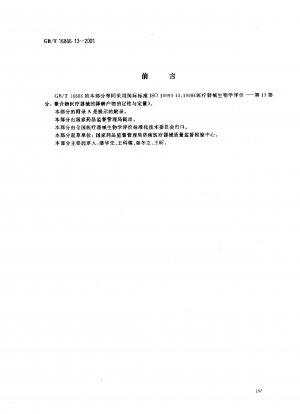GB/T 16886.13-2001
Biological evaluation of medical devices--Part 13:Identification and quantification of degradation products from polymeric medical devices (English Version)
- Standard No.
- GB/T 16886.13-2001
- Language
- Chinese, Available in English version
- Release Date
- 2001
- Published By
- General Administration of Quality Supervision, Inspection and Quarantine of the People‘s Republic of China
- Status
- 2018-07
- Replace By
- GB/T 16886.13-2017
- Latest
- GB/T 16886.13-2017
- Scope
- This part of GB/T 16886 provides guidance on the design of qualitative and quantitative tests for degradation products of finished polymeric medical devices intended for clinical use. This part of GB/T 16886 describes two test methods for the formation of degradation products, one is the accelerated degradation test as a screening method, and the other is the actual time degradation test. For materials that polymerize upon use, the cured polymer is used in the test. The data obtained from the experiment were used for the biological evaluation of the polymer. This part of GB/T 16886 only deals with the degradation products of finished polymer devices due to chemical changes, and does not involve the degradation of polymer devices caused by mechanical stress, friction or electromagnetic radiation. This part of GB/T16886 does not involve the biological activity of fragments and soluble degradation products, and it is recommended to evaluate it according to the principles in GB/T16886.1 and ISO10993-17. Due to the wide range of polymeric materials used in medical devices, no specific analytical technique is specified or specified. This part of GB/T 16886 does not specify specific requirements for acceptable levels of degradation products.
GB/T 16886.13-2001 history
- 2017 GB/T 16886.13-2017 Biological evaluation of medical devices—Part 13: Identification and quantification of degradation products from polymeric medical devices
- 2001 GB/T 16886.13-2001 Biological evaluation of medical devices--Part 13:Identification and quantification of degradation products from polymeric medical devices

GB/T 16886.13-2001 -All Parts
GB/T 16886.1-2022 Biological evaluation of medical devices—Part 1: Evaluation and testing within a risk management process
GB/T 16886.10-2017 Biological evaluation of medical devices—Part 10: Tests for irritation and skin sensitization
GB/T 16886.11-2021 Biological evaluation of medical devices—Part 11: Tests for systemic toxicity
GB/T 16886.12-2023 Biological Evaluation of Medical Devices Part 12: Sample Preparation and Reference Materials
GB/T 16886.13-2017 Biological evaluation of medical devices—Part 13: Identification and quantification of degradation products from polymeric medical devices
GB/T 16886.14-2003 Biological evaluation of medical devices--Part 14: Identification and quantification of degradation products from ceramics
GB/T 16886.15-2022 Biological evaluation of medical devices—Part 15: Identification and quantification of degradation products from metals and alloys
GB/T 16886.16-2021 Biological evaluation of medical devices—Part 16: Toxicokinetic study design for degradation products and leachables
GB/T 16886.17-2005 Biological evaluation of medical devices.Part 17:Establishment of allowable limits for leachable substances
GB/T 16886.18-2022 Biological evaluation of medical devices—Part 18: Chemical characterization of medical device materials within a risk management process
GB/T 16886.19-2022 Biological evaluation of medical devices—Part 19: Physico-chemical, morphological and topographical characterization of materials
GB/T 16886.2-2011 Biological evaluation of medical devices.Part 2: Animal welfare requirements
GB/T 16886.20-2015 Biological evaluation of medical devices.Part 20:Principles and methods for immunotoxicology testing of medical devices
GB/T 16886.23-2023 Biological Evaluation of Medical Devices Part 23: Stimulation Test
GB/T 16886.3-2019 Biological evaluation of medical devices—Part 3: Tests for genotoxicity, carcinogenicity and reproductive toxicity
GB/T 16886.4-2022 Biological evaluation of medical devices—Part 4: Selection of tests for interactions with blood
GB/T 16886.5-2017 Biological Evaluation of Medical Devices Part 5: In Vitro Cytotoxicity Tests
GB/T 16886.6-2022 Biological evaluation of medical devices—Part 6:Tests for local effects after implantation
GB/T 16886.7-2015 Biological evaluation of medical devices—Part 7: Ethylene oxide sterilization residuals
GB/T 16886.9-2022 Biological Evaluation of Medical Devices Part 9: Qualitative and Quantitative Framework for Potential Degradation Products